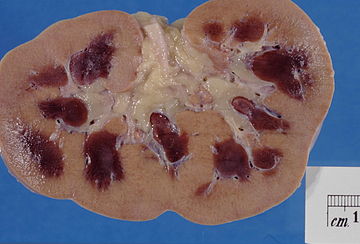Ho sabíeu?
Podeu fer doble clic en una paraula per a buscar-la a TermGallery.
Podeu fer doble clic en una paraula per a buscar-la a TermGallery.
Significats de acute kidney injury en anglès

Abrupt loss of kidney function that develops within 48 hours.
Termes relacionats
Ús de acute kidney injury en anglès
1
Fifty-seven percent developed acute kidney injury during their intensive care unit stay.
2
Further development of QPI-1002 for prophylaxis of acute kidney injury is warranted.
3
The most common complication studied was the 30-day rate for acute kidney injury.
4
One patient suffered acute kidney injury that was successfully medically managed.
5
The use of amoxicillin or azithromycin was not associated with acute kidney injury.
6
Patients with acute kidney injury and prior renal transplant were excluded.
7
She was admitted three years back with acute kidney injury and skin rashes.
8
This study aimed to estimate the excess mortality attributable to acute kidney injury.
9
Progressive tubulointerstitial fibrosis may occur after acute kidney injury due to persistent inflammation.
10
Purpose: N-acetylcysteine may prevent acute kidney injury after cardiac surgery.
11
Five patients were reported to have developed acute kidney injury.
12
His laboratory tests showed that he had acute kidney injury and severe lactic acidosis.
13
Secondary outcomes included acute kidney injury and failure and treatment with renal replacement therapy.
14
Background: Case reports indicate that the use of fluoroquinolones may lead to acute kidney injury.
15
Introduction: Patients undergoing on-pump cardiac surgery are at an increased risk of acute kidney injury.
16
The magnitude of the impact of acute kidney injury on outcome, however, is still unclear.
Translations for acute kidney injury
portuguès

